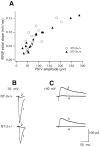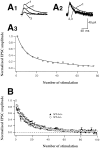Endogenous neurotrophin-3 regulates short-term plasticity at lateral perforant path-granule cell synapses
- PMID: 9786980
- PMCID: PMC6793557
- DOI: 10.1523/JNEUROSCI.18-21-08730.1998
Endogenous neurotrophin-3 regulates short-term plasticity at lateral perforant path-granule cell synapses
Abstract
In the adult brain, neurotrophin-3 (NT-3) is mainly localized in dentate granule cells, and its expression is decreased by various stimuli, e.g., seizure activity. We have examined the role of endogenous NT-3 for excitatory synaptic transmission at lateral perforant path-dentate granule cell synapses using hippocampal slices from NT-3 knock-out (+/-) and wild-type (+/+) mice. Paired-pulse facilitation (PPF) and also short-term synaptic plasticity induced by a brief, high-frequency train of afferent stimulation were reduced, but the expression of long-term potentiation was not affected in the NT-3+/- mice. Incubation of the slices with recombinant NT-3 reversed the deficit in PPF through a mechanism requiring de novo protein synthesis, implying that the impaired short-term plasticity does not result from a developmental alteration. No changes of overall presynaptic release probability, measured by the progressive block of NMDA receptor-mediated synaptic currents by MK-801, or desensitization of AMPA receptors were detected. Because NT-3 expression is reduced after focal seizures, impaired short-term facilitation may represent a protective response that limits the propagation of epileptiform activity from the entorhinal cortex to the hippocampus.
Figures






Similar articles
-
Afferent-specific modulation of short-term synaptic plasticity by neurotrophins in dentate gyrus.Eur J Neurosci. 2000 Feb;12(2):662-9. doi: 10.1046/j.1460-9568.2000.00956.x. Eur J Neurosci. 2000. PMID: 10712646
-
Attenuated LTP in hippocampal dentate gyrus neurons of mice deficient in the PAF receptor.J Neurophysiol. 2001 Jan;85(1):384-90. doi: 10.1152/jn.2001.85.1.384. J Neurophysiol. 2001. PMID: 11152738
-
Recurrent mossy fiber pathway in rat dentate gyrus: synaptic currents evoked in presence and absence of seizure-induced growth.J Neurophysiol. 1999 Apr;81(4):1645-60. doi: 10.1152/jn.1999.81.4.1645. J Neurophysiol. 1999. PMID: 10200201
-
Kindling induces transient NMDA receptor-mediated facilitation of high-frequency input in the rat dentate gyrus.J Neurophysiol. 2001 May;85(5):2195-202. doi: 10.1152/jn.2001.85.5.2195. J Neurophysiol. 2001. PMID: 11353034
-
Neurotrophic factors in brain synaptic plasticity.Crit Rev Neurobiol. 1997;11(1):91-100. doi: 10.1615/critrevneurobiol.v11.i1.50. Crit Rev Neurobiol. 1997. PMID: 9093815 Review.
Cited by
-
NT-3 facilitates hippocampal plasticity and learning and memory by regulating neurogenesis.Learn Mem. 2006 May-Jun;13(3):307-15. doi: 10.1101/lm.76006. Epub 2006 May 16. Learn Mem. 2006. PMID: 16705139 Free PMC article.
-
Relative contribution of endogenous neurotrophins in hippocampal long-term potentiation.J Neurosci. 1999 Sep 15;19(18):7983-90. doi: 10.1523/JNEUROSCI.19-18-07983.1999. J Neurosci. 1999. PMID: 10479698 Free PMC article.
-
A catalytic independent function of the deubiquitinating enzyme USP14 regulates hippocampal synaptic short-term plasticity and vesicle number.J Physiol. 2014 Feb 15;592(4):571-86. doi: 10.1113/jphysiol.2013.266015. Epub 2013 Nov 11. J Physiol. 2014. PMID: 24218545 Free PMC article.
-
TRPC5 channel is the mediator of neurotrophin-3 in regulating dendritic growth via CaMKIIα in rat hippocampal neurons.J Neurosci. 2012 Jul 4;32(27):9383-95. doi: 10.1523/JNEUROSCI.6363-11.2012. J Neurosci. 2012. PMID: 22764246 Free PMC article.
-
Defining a molecular atlas of the hippocampus using DNA microarrays and high-throughput in situ hybridization.J Neurosci. 2004 Apr 14;24(15):3879-89. doi: 10.1523/JNEUROSCI.4710-03.2004. J Neurosci. 2004. PMID: 15084669 Free PMC article.
References
-
- Altar CA, Cai N, Bliven T, Juhasz M, Conner JM, Acheson AL, Lindsay RM, Wiegand SJ. Anterograde transport of brain-derived neurotrophic factor and its role in the brain. Nature. 1997;389:856–860. - PubMed
-
- Asztely F, Xiao MY, Gustafsson B. Long-term potentiation and paired-pulse facilitation in the hippocampal CA1 region. NeuroReport. 1996;7:1609–1612. - PubMed
-
- Bengzon J, Kokaia Z, Ernfors P, Kokaia M, Leanza G, Nilsson OG, Persson H, Lindvall O. Regulation of neurotrophin and trkA, trkB and trkC tyrosine kinase receptor messenger RNA expression in kindling. Neuroscience. 1993;53:433–446. - PubMed
-
- Bliss TV, Collingridge GL. A synaptic model of memory: long-term potentiation in the hippocampus. Nature. 1993;361:31–39. - PubMed
Publication types
MeSH terms
Substances
LinkOut - more resources
Full Text Sources
Molecular Biology Databases
Research Materials
